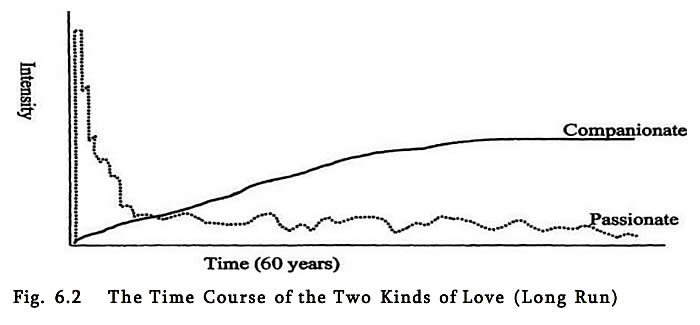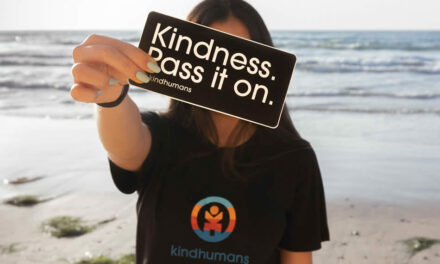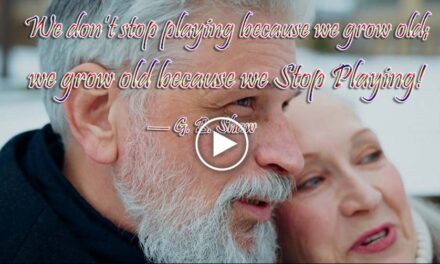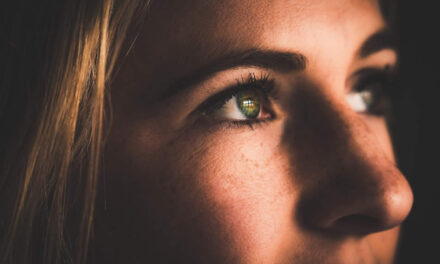The graph I’d like to show the world.
If a magical genie granted you three wishes, what would you ask for?
Before asking for riches and eternal life, I’d gladly “waste” a wish on showing the entire world the following graph:

This graph is from The Happiness Hypothesis, a book by Jonathan Haidt, one of the world’s leading psychologists, and it makes but one simple statement:
In any romantic relationship, two kinds of love co-exist:
There’s passionate love and there’s compassionate love.
We’ve all felt it. We saw them and we were smitten. We couldn’t take our eyes off them. Every second felt magical. We never wanted to let them go, we thought we’d never have to eat again, and we wished each kiss would last forever.
Of course, none of it ever does. Humans are creatures of habit. We get used to even the greatest of pleasures, and so, in life as in this graph, romance peaks early — and then faces a steep, long ride downhill.
Sometimes, it really isn’t meant to last. Most of the time, however, we confuse the exodus of romance for a lack of true love. But if you’ve ever spoken to an old married couple, chances are, you got the impression that it’s quite normal for passion to swing by your door a lot less as your relationship evolves.
Indeed, the graph shows this too: Over the course of 60 years, the flame of romance may flicker — but it never goes out completely. Instead, it turns into a slow, steady burn. It’s never in vain to buy flowers. You’ll always enjoy a spontaneous make-out session. But not eating for days? Maybe it’s good to not repeat that too often.
Compassionate love is the bond that never breaks. It’s trust. Comfort. Care. The backup that’ll always be there when you need it. Compassionate love is a commitment that makes true love last.
I’d love to say we’ve all felt this too, but a lot of us haven’t — at least not in our romantic relationships. I know I didn’t for many years. I hope you have a childhood best friend. A father you love like a brother, or a sister who loves you like a daughter. That is true friendship. That is compassionate love.
Compassionate love is the opposite of its passionate sibling: It takes a long time to form. It builds slowly but steadily with each passing year. As we observe and support each other in facing and overcoming obstacles, in growing, learning, and becoming better humans, our bond gets stronger and stronger.
Unlike romance’s automatic drop, here, it is often us who throw in the towel too early. We don’t give it time. We don’t use trust like credit. We misinterpret, we take things personally, and we run away at the first sign of difficulty. If we stuck around, chances are, eventually, we could watch our relationships soar — just like they do in that graph.
It’s hard to remember all this when you’re head over heels in love. No one wants to think about hospital visits, dog-sitting, and board games when their new flame looks dashing on their third date — but that’s exactly what we should do. That’s what we must remember. Looks don’t last, friendships do.
Lillian Marie Bounds was born in 1899. At the age of 26, she got married. Three years later, she gave her drawing- and cartoon-obsessed husband some advice: “Don’t name your latest character Mortimer. Mortimer sounds so depressing. Why don’t you name him Mickey?”
Thankfully, her husband listened, and, on this day, Mickey Mouse was born. Walt Disney didn’t invent the genie, but his movie Aladdin is responsible for our magical friend now being recognized all over the world.
So please, dear genie, show the entire world Jonathan Haidt’s graph, and make sure everyone understands it. Make sure people internalize the difference between passion and friendship,so that we can stop confusing the two and start building our romantic relationships on a solid foundation of both — with a slight emphasis on the latter over the former.
Passion is like fire: hot and strong and exciting in the beginning, but — as all fires do — it will always, eventually, be reduced to a glimmer. A soft glow will be all that’s left.
Companionship is a vine: Soft and fragile when it sprouts, slow to grow, but forever growing nonetheless — until it’s unbreakable, unstoppable, a net that catches anyone who falls.
Every day, someone screws up their chance of a lifetime, either by taking their best friend for granted or by kissing someone who could be goodbye.
I’ve spent much of my life on the losing side of this graph for various reasons — many of my own making — but I’d gladly do it again and again if it somehow meant I could help the genie spread the message:
When she was in her 90s, someone asked Lillian how she felt about her marriage to Walt. “We shared a wonderful, exciting life, and we loved every minute of it,” she said. “He was a wonderful husband to me, and wonderful and joyful father and grandfather.”
I’m not sure the two would agree with my first wish, but I’d like to think they would. At the time of Walt’s death in 1966, they’d been married for 41 years.
![]()
Best Friends 👫 Wedding Wows' Video 🎞️
If you ever listened to a joke and someone’s laugh beats the joke, and laughter being contagious, then perhaps the following video will satisfy your daily dose of fun.



























